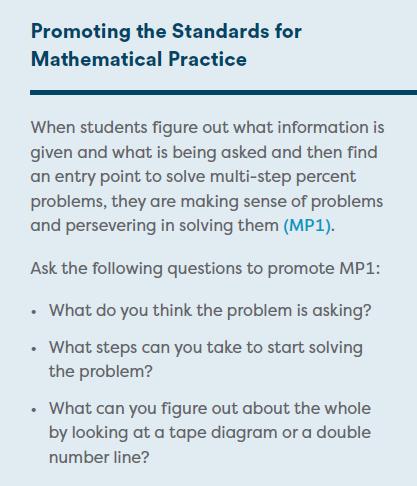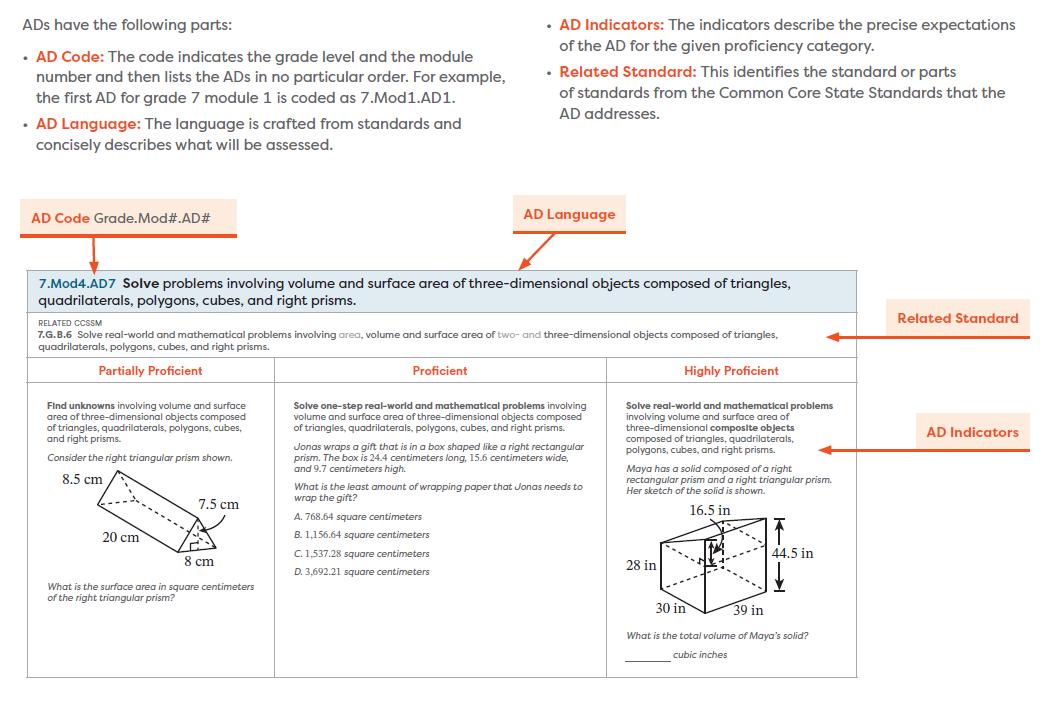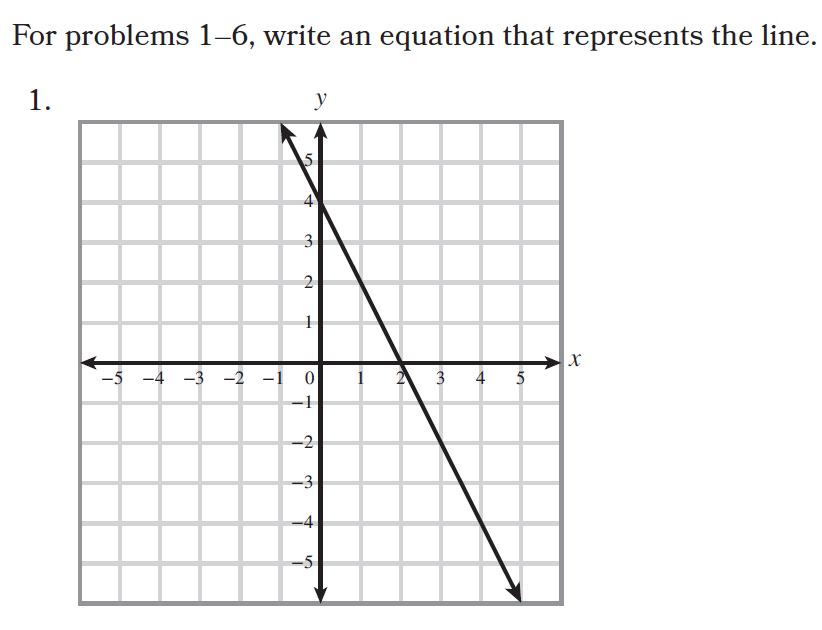
11 minute read
Teachability and Digital Integration

7. Teachability and Digital Integration
A. Curricular materials include embedded and external professional development.
✓ Professional Development is available to Eureka Math2 implementers in many forms, including embedded supports in coaching and implementation services, and many professional development sessions. Teach, digital resources,
One of the great strengths of Eureka Math2 is its educative nature and its usefulness as point-of-use professional development. Extensive teacher notes throughout the curriculum provide explanations of important mathematical concepts and discussions about pedagogy, language, notation,
Student Reports
• Students have access to reports and can review their responses, scores, and any feedback provided by the teacher.
• Student-level reports can be downloaded and sent to parents.
Administrator Reports
• These reports allow administrators to view school- and district-level performance data.
When items must be hand-scored, whether they are given digitally or in a paper-and-pencil format, guidance is provided in the assessments’ Sample Solutions and Scoring Guide.
Practice problems allow students the opportunity to self-assess and provide teachers the opportunity to informally assess students’ conceptual understanding, procedural skill and fluency, and application skills.
i. Materials support teacher learning and understanding of mathematical concepts, the progression of learning, and instructional pedagogy. ii. Materials include standards alignment information and explain the role of the standards in the resources.
The Teachbook includes module and lesson study tools for teachers. The Module Overview explains the development of the mathematics in each topic of the module and highlights connections to work that occurs before and after the module, helping teachers to understand the module’s place in the overall development of learning in and across grade levels. The Module Overview also includes a Why section. This section highlights and explains elements of the mathematics in the module. It also gives insight into the pedagogical decisions the authors made. The Why section helps teachers understand the underlying structure of the module, including the flow and coherence of the content.
Each topic begins with a Topic Overview. The Topic Overview explains the mathematics and the major learning in the topic, and it typically includes information about how learning connects to previous or upcoming content. Lesson Progressions charts highlight student work and language aligned with each objective.
Modeled student–teacher sample dialogue and sample student responses in each component of each lesson provide teachers with a picture of how the lesson might look and sound while creating a clear conceptual understanding of the pedagogical content knowledge for the teacher. This sample dialogue is intended as a helpful guide, not a script.
The Standards resource lists the content standards associated with each module as well as the Standards for Mathematical Practice. Achievement Descriptors (ADs) provided for each module are standards-aligned descriptions that detail what students should know and be able to do based on instruction they receive.
B. Curricular materials include support for implementation. i. The materials are visually engaging, easy to use, and well organized for students and teachers. ii. Materials provide information about how to plan and prepare lessons. iii. Materials provide
✓ The Teach and Learn printed books help teachers facilitate student learning both inside and outside the classroom. The Teach book and accompanying digital resources contain all the information a teacher needs to study and prepare for instruction. Similarly, the Learn book and accompanying digital resources have all the resources a student needs to be successful when learning grade-level concepts. The Great Minds® Digital Platform grants teachers access to the full Eureka Math2 experience, including the contents of Teach and Learn and additional resources like Equip and the assessments.
This collection of resources uses consistent naming to assist with navigation. For example, all levels have six modules which are broken into topics and lessons. The visual design of the resources is consistent, engaging, and focused. The Teach book is spiral-bound. Quality color images are used throughout in visuals, models, and sample solutions.
The Overview in each Teach book is a summary of the module by topic. It shows the development of learning over the module. The Overview identifies connections to work that occurs before the module and after the module, which supports the understanding of the module’s place in the overall development of learning in and across the grade levels.
The Why section of the Overview gives teachers insight into the decisions that authors made when writing the module. This insight helps teachers understand the underlying structure, flow of content, and coherence of content between modules and grade levels.
The Topic Overview is a summary of the development of learning over each topic. It typically includes information about how learning connects to previous or upcoming content. It also includes a Progression of Lessons table that shows how students engage with each lesson objective over the course of the topic.
Each lesson begins with two pages of information to help teachers prepare to teach the lesson. To guide lesson planning and instructional delivery, each lesson begins with a lesson overview that includes the Lesson at a Glance, a snapshot of the lesson framed through what students should
guidance for instructional delivery, including questions to prompt student thinking and expected student outcomes.
know, understand, and do while engaging with the lesson. The lesson overview also features one or more Key Questions, which encapsulate the key learning of the lesson and develop coherence or connections to other concepts or a deeper understanding of a strategy or model. These questions help teachers focus instruction and guide classroom discourse, and students discuss them to synthesize their learning during the Land section of the lesson. In addition, each lesson includes at least one student objective and the lesson overview defines clear student outcomes for each lesson by including a preview of the Exit Ticket and the Achievement Descriptors.
The lesson overview also details which teacher and student materials are needed for delivery of the lesson, as well as what teachers must prepare in advance of teaching the lesson. The module’s Materials resource lists items that teachers and students need for the module facilitating module and year-long planning.
Each lesson’s facilitation includes sample dialogue that represents how the teacher and students in a classroom might explore concepts and problems and gives a sense of how instruction might look and feel. The sample dialogue helps teachers identify lines of questioning that advance students toward the objective(s), determine when and how to use precise terminology, or navigate content that might be new or challenging to teach or learn. The sample student responses given in the lesson facilitation give teachers guidance about possible student ways of thinking and the variety of possible student responses.
Six types of instructional guidance appear in the margin of lessons. Teacher Notes communicate information that helps with lesson implementation (e.g., enhance mathematical understanding, explain pedagogical choices, give background information, support student thinking). Margin notes also have information related to Universal Design for Learning (UDL), Language Support, Differentiation, Standards for Mathematical Practice, and Math Past.
The Eureka Math2 Implementation Guide™, a free digital resource, is Great Minds’ comprehensive guide for teaching the curriculum. The resource provides a detailed lesson preparation method to help teachers connect all lesson components organically and to anticipate any classroom challenges. It provides a detailed overview of all curriculum components, as well as guidance for lesson preparation, sample dialogue, best practices for classroom culture, effective delivery of instructional routines, pacing guidance, and assessment overviews.
Digital resources are intuitive and easy to use. They include a Help Center that contains articles that support teachers with navigating the digital and print resources.
C. Curricular materials can be completed within a regular school year and guidance about the amount of time lessons and tasks may take is provided.
✓ Each grade level in Eureka Math2 is organized into six modules that contain a total of about 130 lessons, along with 30 more days for assessment and responsive teaching. Optional lessons are included in the total number of lessons and are clearly designated. Lessons may be optional for the following reasons:
• The lesson is primarily for enrichment. • The lesson offers more practice with skills, concepts, or applications. • The lesson bridges gaps between standards. Lessons are designed for the average length of an instructional period, 45 minutes. All lessons are designed for one instructional period. To provide pacing guidance in the lesson, the Lesson at a Glance in the Teach book contains an Agenda for each lesson, detailing the amount of time each lesson component should take.
Furthermore, the Eureka Math2 Implementation Guides contain a Year at a Glance section which outlines the modules and lessons in a year at each grade level and provides pacing suggestions for each grade-level band.
D. Curricular materials provide caregivers with resources to
✓ Great Minds realizes that parents and family members are students’ biggest advocates and therefore works to keep them engaged in the learning process.
Each lesson in students Learn book contains a Recap. The Recap lists the keys ideas from the lesson, definitions for any new content terminology
support student academic progress.
E. A user-friendly online platform provides always-on access to curricular materials and additional resources.
and relevant formulas. It also includes worked out problems that are similar to those in the Practice with call out boxes throughout that help students understand the solution. The lesson Recaps serve as a useful review tool for students, as well as a guide for caregivers who are supporting
their student at home. In addition, this resource supports students in their at-home learning and are useful for anyone supporting the child’s learning including family members, tutors, and special educators.

✓ The Great Minds Digital Platform grants teachers access to the full Eureka Math2 experience. The Teachand Learnprint books help teachers facilitate student learning both inside and outside the classroom. A streamlined, interactive digital platform makes it simple to access and navigate Eureka Math2 teacher and student materials and resources online. The Great Minds Digital Platform supports effective planning, instruction, and assessment throughout the school year.
Educators can view and access all levels of the Eureka Math2 curriculum via the platform. For each level, all the resources in the print Teach book are in a digital format that offers additional features not available in print. While planning and reflecting, educators can highlight and take notes in the digital version of Teach to note customizations for individuals or groups or to reflect on for future years. In addition to accessing all lesson plans and resources, teachers can assign student pages as PDFs, launch digital assessments, access assessment reports, and provide student feedback. The platform also includes lesson presentation slides that include images, student pages, videos, and digital interactives.
Digital resources for teachers include the following:
F. Digital materials and experiences enhance
✓ The student digital experience is designed to enhance the overall mathematical content learning experience. Eureka Math2 digital tools empower the teacher and invite more students into classroom discourse. Digital materials such as digital lessons, context videos, digital interactives, and
o Curriculum Map
o Grade-level modules
o Module resources
o Topic resources
o Assessments
o Lesson resources including:
• Digital lessons
• Presentation slides that may contain the following:
• Fluency activities
• Images and text for lesson facilitation
• Digital interactives and demonstrations to spark student curiosity, illustrate mathematical concepts, and fuel discussions
• Context videos
• Assign: Assign and manage any of the student facing resources in the Learnand Applybooks to full classes or individual students. Monitor student progress on assignments, score and leave feedback on completed assignments, and access and edit past and upcoming assignments.
• Assess: Use filters to search for available digital assessment in the assessment library. Assign assessments to full classes or to individual students.
• Analyze: View assessment reports to quantitatively measure student understanding. Administrator- and teacher-facing reports provide visibility into individual and class performance on assessments and standards.
Resource Center
• Announcements: Find important announcements from the Eureka Math2 and Great Minds teams. Look specifically for the What’s New articles, which detail platform updates and feature releases.
• Prototypes: Access available prototypes for user testing and feedback. The collected feedback informs further development of the product.
• Guides: Access all walkthrough platform guidance for quick recall.
• Help Center: View articles and videos to get answers to frequently asked platform and curriculum and implementation questions. These articles and videos are updated regularly.
• Implementation Guides: Navigate directly to the implementation guides for the Eureka Math2 curriculum.
• Great Minds blog: Visit the Great Minds Aha! Blog to read articles to support with implementation of Eureka Math2 .
classroom instructional practice, engaging students meaningfully to develop mathematical understanding.
Every module contains digital lessons accessed on the digital platform. These lessons fit into the existing sequence of lessons and are engaging classroom experiences centered around peer feedback and sharing student thinking. Digital lessons contain interactive slides that students access on their device. These slides allow students to engage with mathematical concepts and provide meaningful feedback. Digital lessons also allow the teacher to see responses from all students and use selected responses to facilitate rich discussions that drive the key concepts of the lesson.
In addition, other lessons provide teacher guidance for the use of embedded technology to support and enhance student learning.
Digital resources for students include the following:
• Annotation tools to complete digital assignments.
• Tools for completing digital assessments, including various accessibility tools.
• Access to presentation slides including context videos and digital interactives.
• A student “locker” that contains all previously completed assignments and assessments, as well as scores and feedback left by the teacher on those assignments and assessments.
• Access to virtual manipulatives though our partner Didax.







